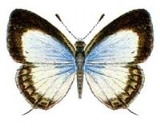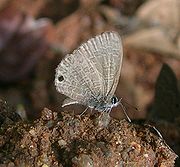
Nacaduba kurava
Encyclopedia
The Transparent Six-line Blue Nacaduba kurava is a species of Lycaenid
butterfly found in Asia
.
 Male upperside: pale dull violet with in certain lights a frosted silvery sheen; bases of wings suffused slightly with blue. Fore wing: a slender anticiliary dark brown line. Hind wing: costa broadly paler; dorsum brownish; in most specimens the sub-terminal spots in interspaces 1 and 2 show through by transparency from the underside, in a few these spots are marked by actual scaling; an anticiliary dark brown line as in the fore wing. Underside: brown. Fore wing: transversely traversed by three pairs of white strigae, the innermost pair slightly curved, from subcostal vein to vein 1 across the middle of the cell; the inner striga of the medial pair complete, crosses on the inner side of the discocellulars from subcostal vein to vein 1, the outer striga beyond the discocellulars from vein 7 to vein 1, interrupted in interspace 5; the outer pair of strigae are discal and cross -from vein 7 to vein 3, the inner striga of the pair impinging at vein 3 on the outer striga of the medial pair; these are followed by an inner and an outer subterminal slender lunular line, a terminal series of slender transversely linear spots edged outwardly by a very slender white, and an anticiliary dark brown line. Hind wing: crossed by six or seven irregular, more or less broken, sublunular, white striations; terminal markings similar to those on the fore wing; interspace 1 with a minute, interspace 2 with a much larger round jet-black spot, both spots crowned inwardly with ochraceous orange and touched outwardly with glittering metallic blue scales. Antennae black, the shafts obscurely speckled with white on the sides; head, thorax and abdomen purplish brown; beneath: the palpi fringed with black hairs, the thorax bluish white, abdomen white.
Male upperside: pale dull violet with in certain lights a frosted silvery sheen; bases of wings suffused slightly with blue. Fore wing: a slender anticiliary dark brown line. Hind wing: costa broadly paler; dorsum brownish; in most specimens the sub-terminal spots in interspaces 1 and 2 show through by transparency from the underside, in a few these spots are marked by actual scaling; an anticiliary dark brown line as in the fore wing. Underside: brown. Fore wing: transversely traversed by three pairs of white strigae, the innermost pair slightly curved, from subcostal vein to vein 1 across the middle of the cell; the inner striga of the medial pair complete, crosses on the inner side of the discocellulars from subcostal vein to vein 1, the outer striga beyond the discocellulars from vein 7 to vein 1, interrupted in interspace 5; the outer pair of strigae are discal and cross -from vein 7 to vein 3, the inner striga of the pair impinging at vein 3 on the outer striga of the medial pair; these are followed by an inner and an outer subterminal slender lunular line, a terminal series of slender transversely linear spots edged outwardly by a very slender white, and an anticiliary dark brown line. Hind wing: crossed by six or seven irregular, more or less broken, sublunular, white striations; terminal markings similar to those on the fore wing; interspace 1 with a minute, interspace 2 with a much larger round jet-black spot, both spots crowned inwardly with ochraceous orange and touched outwardly with glittering metallic blue scales. Antennae black, the shafts obscurely speckled with white on the sides; head, thorax and abdomen purplish brown; beneath: the palpi fringed with black hairs, the thorax bluish white, abdomen white.
Female upperside, fore wing: costa above the cell, apex very broadly and a terminal edging that occupies about one-third of the length of the wing jet-black, this colour on the costa widened outwards ; the remainder of the wing white shaded with dusky greyish which in certain lights has a beautiful metallic blue iridescence; on the inner side of the terminal edging is a transverse, very ill-defined, diffuse dusky band, and enclosed between it and the black edging three somewhat prominent spots of the white ground-colour. Hind wing: costal margin above a longitudinal line through the middle of the cell dusky black; posterior portion of the wing dusky bluish, veins prominently black; a comparatively well-defined transverse postdiscal series of black lunules edged inwardly and outwardly by similar series of white lunules, followed by a subterminal series of black spots with an outer edging of white and an anticiliary jet -black line; the subterminal spots decrease in size anteriorly, those in interspaces 2 and 3 the largest, the two spots in interspace 1 minute and geminate; tail black tipped with white. Underside: similar to that of the male but the ground-colour grey with a slight tint of brown, the transverse white strigae much broader, somewhat diffuse; on the fore wing the band formed by the medial pair of strigae much more broken than in the male the posterior portion below vein 3 shifted well outwards; on the hind wing the sub-terminal black spot in interspace 2 comparatively very large and prominent. Antenna as in the male; head, thorax and abdomen brown; beneath: the palpi, thorax and abdomen as in the male.
Lycaenidae
The Lycaenidae are the second-largest family of butterflies, with about 6000 species worldwide, whose members are also called gossamer-winged butterflies...
butterfly found in Asia
Asia
Asia is the world's largest and most populous continent, located primarily in the eastern and northern hemispheres. It covers 8.7% of the Earth's total surface area and with approximately 3.879 billion people, it hosts 60% of the world's current human population...
.
Description

Female upperside, fore wing: costa above the cell, apex very broadly and a terminal edging that occupies about one-third of the length of the wing jet-black, this colour on the costa widened outwards ; the remainder of the wing white shaded with dusky greyish which in certain lights has a beautiful metallic blue iridescence; on the inner side of the terminal edging is a transverse, very ill-defined, diffuse dusky band, and enclosed between it and the black edging three somewhat prominent spots of the white ground-colour. Hind wing: costal margin above a longitudinal line through the middle of the cell dusky black; posterior portion of the wing dusky bluish, veins prominently black; a comparatively well-defined transverse postdiscal series of black lunules edged inwardly and outwardly by similar series of white lunules, followed by a subterminal series of black spots with an outer edging of white and an anticiliary jet -black line; the subterminal spots decrease in size anteriorly, those in interspaces 2 and 3 the largest, the two spots in interspace 1 minute and geminate; tail black tipped with white. Underside: similar to that of the male but the ground-colour grey with a slight tint of brown, the transverse white strigae much broader, somewhat diffuse; on the fore wing the band formed by the medial pair of strigae much more broken than in the male the posterior portion below vein 3 shifted well outwards; on the hind wing the sub-terminal black spot in interspace 2 comparatively very large and prominent. Antenna as in the male; head, thorax and abdomen brown; beneath: the palpi, thorax and abdomen as in the male.

